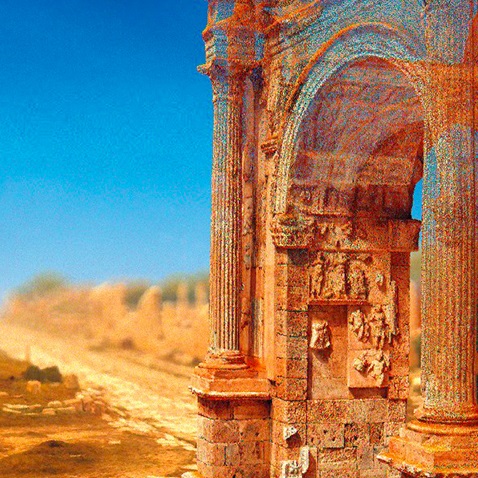For the First Time in the US, Visitors Can Experience “Age Old Cities”—A Virtual Journey to the Devastated Sites of Mosul, Aleppo and Palmyra
Using the most recent digital techniques, the Freer Gallery of Art and the Arthur M. Sackler Gallery, the Smithsonian’s National Museum of Asian Art, take visitors on a virtual tour of three ancient cities—Palmyra and Aleppo in Syria and Mosul in Iraq.
The exhibition, located in the Sackler Gallery, highlights the devastation of these historically significant sites but also offers hope for their reconstruction and rehabilitation. By including the testimony of Iraqis and Syrians, the installation underscores the importance of place in the preservation of historical and architectural memory.
“Age Old Cities: A Virtual Journey from Palmyra to Mosul” will be on view at the Sackler Gallery from Jan. 25 through Oct. 26. It was organized by the Arab World Institute in Paris, and created in collaboration with Iconem, which specializes in digitizing cultural heritage sites in 3-D, and in partnership with UNESCO. The exhibition offers an immersive experience that emphasizes the importance of preserving the world’s fragile cultural and built heritage.
“‘Age Old Cities’ is a landmark exhibition, not only for its innovative use of digital technology within a museum context, but also for the poignant story it tells,” said Chase F. Robinson, the Dame Jillian Sackler Director of the Arthur M. Sackler Gallery and the Freer Gallery of Art. “This exhibition narrates the heartbreaking story of cultural destruction—and resilience—in these cities, and we are proud to be the exhibition’s inaugural U.S. venue. Palmyra, Mosul and Aleppo are cornerstones of world culture, and it is our shared responsibility to ensure that these cities are preserved to continue to tell their rich histories and inspire future generations.”
In the recent past, Iraq and Syria have suffered profound upheavals that have destroyed many significant cultural and religious sites—leaving little of the rich historical past. “Age Old Cities” sheds light on the devastating destruction, the important cultural heritage of Syria and Iraq, and the need to preserve these sites.
The exhibition invites visitors into the heart of each of the three cities with large-scale projections of dynamic imagery and 3-D reconstructions of damaged monuments. The projections shift gradually from destruction to progressive reconstruction. To contextualize the sites, visitors will also see projections of historical photographs of the structures.
“Beyond the stones, this heritage is a common good, and safeguarding it is the responsibility of all,” said Jack Lang, president of the Arab World Institute. “Citizens of every faith, archaeologists and curators have all worked and continue working today hand in hand to shelter, protect and rebuild.”
The exhibition offers more than a visual of potential reconstruction of mostly destroyed sites; it introduces visitors to the people who still live in the cities. Several videos throughout the exhibition feature interviews with residents, as well as archeologists and curators who work at great personal risk to protect and preserve these sites. Other videos explore unique parts of the cities such as the souks (markets) of Aleppo or the tomb of the Three Brothers in Palmyra (an underground burial chamber turned into an ISIS base of operations).
Throughout the run of the exhibition, the museum will offer a series of programs focusing on each city. Programming will include lectures and presentations on architectural heritage and current events, family programs and related film and music programs to enhance the visitor experience, further explore the rich cultures of these cities, as well as the challenges and opportunities of cultural restoration and public policies.
The exhibition is created by the Arab World Institute, in collaboration with Iconem and in partnership with UNESCO and Ubisoft, with support from the University of Lausanne and L’Oeuvre d’Orient.
About the Freer and Sackler
The Freer Gallery of Art and Arthur M. Sackler Gallery, the Smithsonian’s National Museum of Asian Art, are located on the National Mall in Washington, D.C. Committed to preserving, exhibiting and interpreting exemplary works of art, the Freer and Sackler house exceptional collections of Asian art, with more than 42,000 objects dating from the Neolithic period to today. Renowned and iconic objects originate from China, Japan, Korea, South and Southeast Asia, the ancient Near East and the Islamic world. The Freer Gallery also holds a significant group of American works of art largely dating to the late 19th century. It boasts the world’s largest collection of diverse works by James McNeill Whistler, including the famed Peacock Room.
The Freer Gallery of Art and Arthur M. Sackler Gallery are dedicated to increasing understanding of the arts of Asia through a broad portfolio of exhibitions, publications, conservation, research and education. The museum is free and open to the public 364 days a year (closed Dec. 25).
# # #
SI-10-2020
Juliette Pasquini
202-655-9403
Sai Muddasani
(202) 633-0408 muddasanis@si.edu

